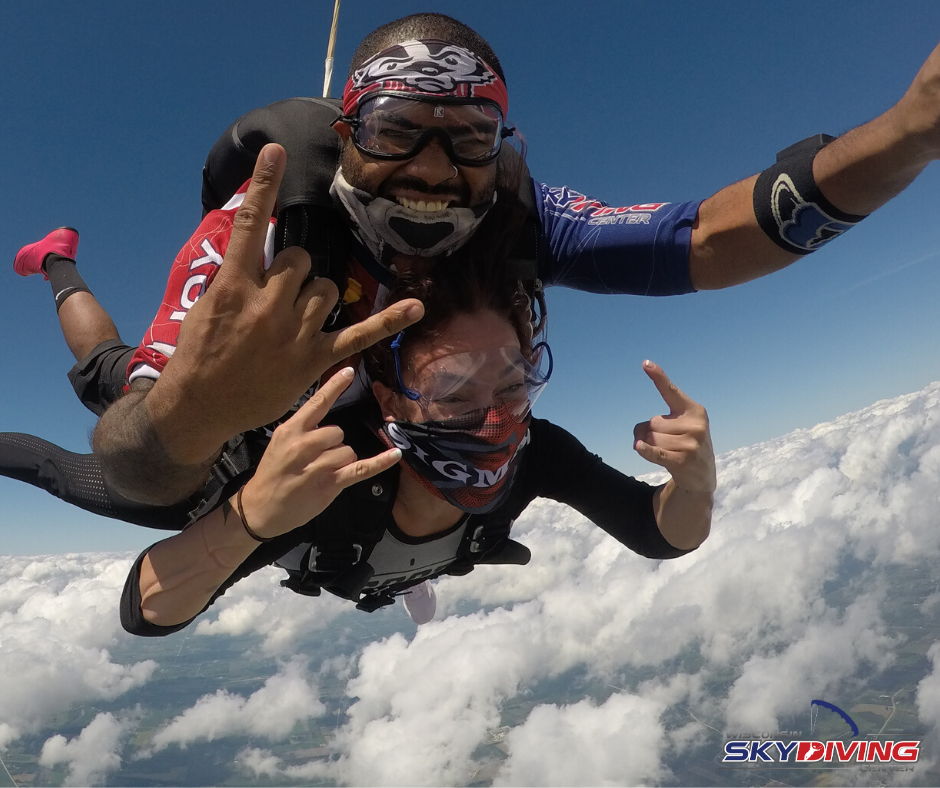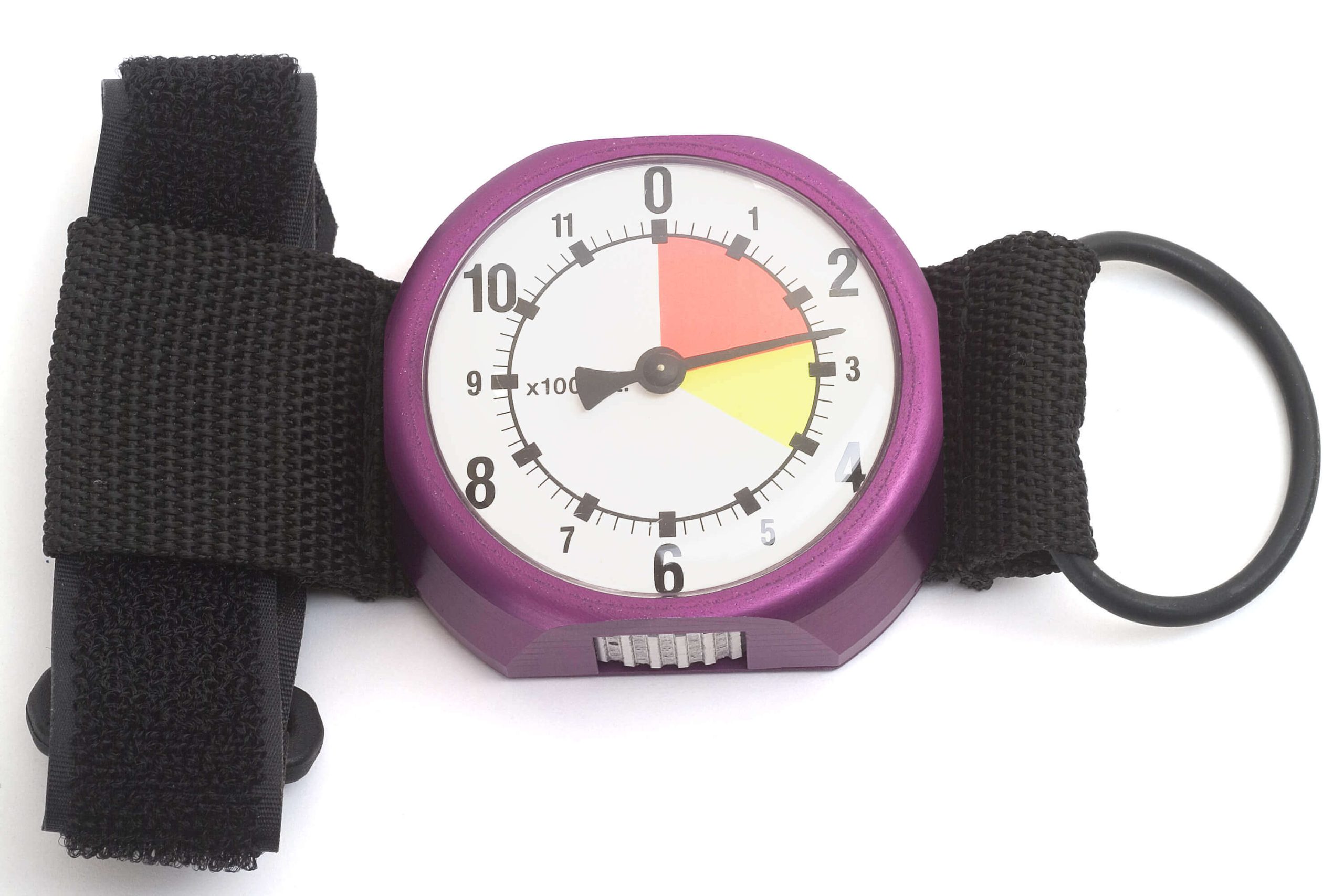Skydiving Altimeter: How It Works
General
Posted by: Wisconsin Skydiving Center 4 months ago
Every time you skydive, you’re counting on a small (but mighty) piece of gear: the skydiving altimeter. Whether you’re a complete beginner about to make your first solo jump, an experienced skydiver who has never really thought about the tech behind the gear, or someone who’s simply curious about what makes this piece of equipment so essential, this is for you!
Understanding the skydiver altimeter can make skydiving less intimidating and easier to navigate. Let’s get into it!

What Is An Altimeter In Skydiving?
A skydiving altimeter is simply an instrument used to measure the height of an object (or person) in relation to a predetermined reference point, such as the ground. When we want to know how high up we are while skydiving – whether this be in the airplane, while in freefall, or under parachute – we rely on our altimeter.
Where are altimeters worn in skydiving? Although there are exceptions, such as wingsuiters who mount them on their chest straps, altimeters are commonly worn on top of the left hand or on the wrist – a skydiving altimeter watch, of sorts! This location makes the altitude measurement easily readable for the jumper* during every scenario – in the plane, during freefall, and while flying under the canopy.
Why specifically the left hand? Unless a skydiver is differently abled and uses adaptive gear, we deploy our parachute with our right hand! The pilot chute is deployed from the right side of the rig. And while we’re in the process of throwing our pilot chute and initiating deployment of the main canopy, we are looking at our altitude on our other hand.
* When you’re tandem skydiving, your instructor wears the altimeter!
How Does A Skydiving Altimeter Work?
What is the principle of working an altimeter? Let’s cover the basics with a quick example. Have you ever heard the term barometric pressure said on the weather channel? Meteorologists use barometers to measure pressure changes and predict the weather.
For example, a decrease in atmospheric pressure (called a “low pressure system”) tells us that some clouds or rain may be on the way. Just like those used to predict weather changes, skydiving altimeters are a type of aneroid barometer.
So, how does an altimeter know how high you are? Air pressure! As we climb higher in the sky, the air pressure decreases, and as we descend, the air pressure increases. An altimeter contains a small metal box, called a capsule, that sort of changes shape as the air pressure changes. This correlates directly to the altitude number displayed to the jumper.
What is the difference between an altimeter in skydiving and a barometer in the weather world? An altimeter in skydiving is just a type of barometer. The biggest differentiating factor between the two is where they measure air pressure from. Skydiving altimeters are used at different altitudes by physically moving up and down, and match a certain pressure to a corresponding altitude. On the other hand, barometers are kept at a steady level and measure slight changes in weather.

Analog Altimeter v Digital Altimeter
What is the best skydiving altimeter? Well, it depends on who you are!
Digital Altimeters
Many experienced skydivers prefer to bring a digital altimeter skydiving because they provide more precise readings and offer additional features, like customizable alarms and data logging. Digital altimeters are also more versatile than their analog counterparts in that they can be worn on the wrist, forearm, or hand.
On the other hand, many new digital altimeter users catch themselves frustrated and ask, “How does the altimeter setting work!?” The settings on a digital altimeter in skydiving can be a bit trickier to understand than those on an analog altimeter. It’s not uncommon for a skydiver who slaps on a brand new digital altimeter to accidentally have it set to show the speed instead of the altitude. Both of these settings show a clear “zero” on the ground (because you’re not moving fast, and you’re also on the ground, which is depicted as zero in the altitude world).
Without a thorough gear check, you may find yourself in the plane with an altimeter functioning on the wrong setting! But, this is avoided with meticulous self-supervised and buddy gear checks.
Analog Altimeters
Some jumpers (usually our old school shredders) choose to take an analog altimeter skydiving with them. They may be a bit clunkier, but they can be easier to read, as the display is a bit bigger. They look sort of like a clock and have a big yellow and orange or red section on the face to show the jumper they’re approaching deployment altitude. Just like a clock, they have a hand, and this hand spins around to show the altitude.
On the other hand, the digital altimeters display a number across the screen that changes every second. When deciding which altimeter is right for you, it’s all about personal preference!
What Is An Audible Altimeter?
An audible altimeter is commonly referred to as just an “audible.” These little guys are placed snuggly inside the helmet of a skydiver and rest against the ear. They work the same way as other altimeters – on a pressure system – but at preset altitudes they release a loud beep.
Audibles are critical for jumpers who pursue disciplines that don’t allow them to physically look at their altimeter as much as they may like to. For example, angle flying is a discipline where jumpers angle their bodies to initiate horizontal speed in freefall. It entails their hands (and hence, their altimeters) being down at their sides and slightly behind them. It would be pretty difficult to bring their hand up in front of their face while maintaining a stable position with their body – this is where an audible comes in handy!

We hope this has helped make the world of skydiving feel more accessible and that you’ve gained some insight into the precision of our gear! Ready to see an altimeter in action in real life? Come jump with us! Blue skies!
Categories:
You May Be Interested In:

Can You Skydive Into Water?
3 weeks ago by Wisconsin Skydiving Center

Staff Spotlight: Dario Meloni
4 weeks ago by Wisconsin Skydiving Center

Can You Skydive With Dentures?
2 months ago by Wisconsin Skydiving Center

Does Skydiving Change Your Life? 5 Powerful Ways It Can.
2 months ago by Wisconsin Skydiving Center